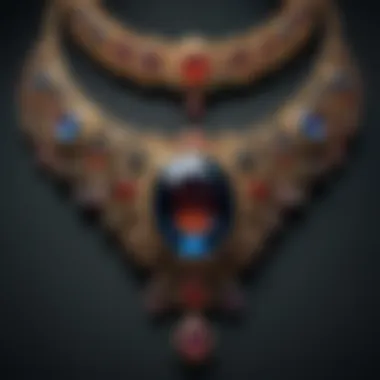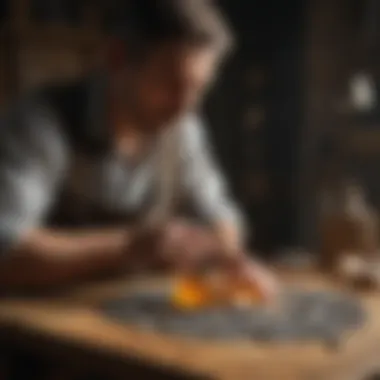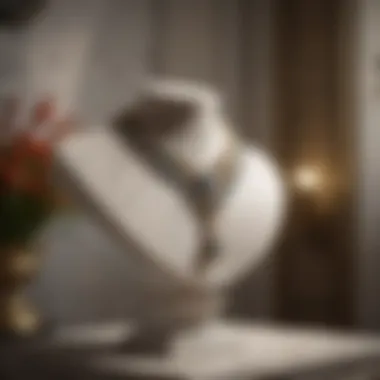Mastering the Art of Crafting Exquisite Stone Necklaces


Rock and Fossil Identification
The process of creating exquisite necklaces with stones begins with a keen understanding of rock and fossil identification. Exploring the diverse array of stones and fossils is crucial to selecting the perfect materials for your unique piece. Types of rocks and fossils vary greatly in color, texture, and composition, offering a myriad of options for your design. When identifying stones, characteristics to look for include hardness, luster, and any distinctive patterns or inclusions that add to their beauty. Utilizing tools such as magnifying glasses, scratch plates, and UV lights can aid in accurate identification, ensuring precision in crafting your necklace.
Collecting Tips and Techniques
Delving into the world of collecting stones is a thrilling adventure for any enthusiast. To embark on this journey, it is essential to adhere to best practices for collecting. This involves obtaining necessary permits when collecting in public areas and respecting the environment by only extracting specimens where permitted. Locating prime collecting sites can greatly enhance your chances of discovering unique stones and fossils. Researching geological maps and joining local rock-hounding clubs can provide valuable insights into promising collecting locations. When collecting, it is important to follow safety protocols to ensure a secure extraction process, including wearing protective gear and using appropriate tools to avoid damage to specimens.
Preservation and Display
Once you have acquired your treasures, mastering preservation techniques is essential for maintaining their beauty and integrity. Utilizing methods such as cleaning with gentle soap and water, sealing with preservatives, and storing in a dry, cool environment can help in preserving rocks and fossils for years to come. Proper storage methods involve protecting specimens from sunlight exposure, moisture, and fluctuations in temperature, safeguarding their condition. When it comes to displaying your collection, creativity plays a key role. Considering options such as shadow boxes, glass domes, or custom-made stands can showcase your stones and fossils in a visually appealing manner, allowing them to shine as unique artworks.
Geological Insights
Unraveling the geological mysteries behind rocks and fossils adds a deeper layer of appreciation to your collection. Understanding geological formations and processes provides insight into the origins and properties of these natural treasures. Delving into the historical significance of rocks and fossils unveils their role throughout different eras and civilizations, offering a glimpse into the earth's rich history. Exploring notable discoveries in the field can spark curiosity and inspiration, driving further exploration and appreciation for the world beneath our feet.
Introduction to Stone Necklaces
In the world of jewelry-making, the craft of creating stone necklaces holds a unique allure that has captivated artisans and enthusiasts for ages. This article serves as a comprehensive guide to understanding the intricate artistry involved in crafting necklaces adorned with stunning stones. From the initial selection of stones to the final assembly of the necklace, each step in this creative process plays a vital role in producing a piece that seamlessly blends beauty and craftsmanship. Whether you are a novice seeking to explore a new hobby or an experienced jeweler looking to expand your repertoire, delving into the realm of stone necklaces offers a rewarding journey filled with creativity and expression.
Understanding the Appeal of Stone Necklaces
Connecting with Nature
Exploring the realm of stone necklaces provides a unique opportunity to foster a deep connection with the natural world. By incorporating earth-derived elements into wearable art, individuals are able to embrace the raw beauty and grounding energies that stones inherently possess. This connection with nature not only adds a sense of authenticity to the jewelry piece but also allows wearers to carry a piece of the earth's essence with them, promoting a harmonious balance between nature and self.
Symbolism and Meaning
The incorporation of symbolism and meaning in stone necklaces adds layers of significance and personalization to the jewelry piece. Each stone carries its own unique story and metaphysical properties, allowing individuals to infuse their creations with intentions that resonate with their beliefs and aspirations. By understanding the symbolic meanings behind different stones, wearers can imbue their necklaces with a sense of purpose and empowerment, turning them into meaningful tokens that hold sentimental value.
Unique Aesthetic Appeal
One of the standout features of stone necklaces lies in their unparalleled aesthetic appeal. The natural variations in color, texture, and shape of stones create visually stunning compositions that are distinctively different from mass-produced jewelry pieces. The unique patterns and formations found in stones lend an element of individuality to each necklace, ensuring that no two pieces are exactly alike. This aesthetic versatility allows creators to design necklaces that range from sleek and modern to bohemian and bold, catering to a wide spectrum of personal styles and preferences.
History and Cultural Significance
Ancient Origins


Choosing the Right Stones
Choosing the right stones is a pivotal aspect of creating exquisite necklaces that resonate with your desired aesthetic and energy. In the realm of stone necklaces, the selection of stones plays a crucial role in the overall allure and impact of the final piece. Whether you are drawn to the raw beauty of gemstones or the polished elegance of crystals, each type imparts its unique charm and significance to the necklace.
Types of Stones for Necklaces
Raw Gemstones
Raw gemstones possess a raw, unrefined allure that speaks to the earth's natural elegance. Their rugged appearance and untamed energy make them a popular choice for those seeking a closer connection to nature. Raw gemstones infuse necklaces with a rustic appeal, adding a touch of raw beauty to the jewelry piece.
Polished Crystals
Polished crystals exude a sense of refinement and sophistication, boasting a smooth and lustrous surface that catches the light effortlessly. Their clarity and brilliance make them a favored choice for those seeking a more polished and elegant look in their necklaces. Polished crystals bring a shimmering quality to the jewelry, elevating its overall aesthetics.
Tumbled Stones
Tumbled stones are known for their smooth, rounded appearance, resulting from the tumbling process that enhances their natural beauty. Their soft shape and comforting feel make them a popular choice for creating soothing and calming necklaces. Tumbled stones add a sense of serenity and balance to the jewelry piece, perfect for those seeking a harmonious design.
Color, Shape, and Energy
Color Psychology
Color psychology plays a vital role in stone selection for necklaces, as each hue carries unique meanings and energies. From the passionate red of garnet to the calming blue of aquamarine, colors can evoke specific emotions and intentions when incorporated into jewelry. Understanding the psychology behind colors allows crafters to imbue their necklaces with deeper meaning and resonance.
Shapes and Cuts
The shapes and cuts of stones can dramatically impact the overall aesthetics of a necklace, influencing its visual appeal and energy. Whether opting for faceted gemstones for a dazzling sparkle or smooth cabochon cuts for a more subdued elegance, the choice of shape and cut determines the necklace's style and statement. Selecting stones with the right shapes and cuts is essential in creating a harmonious and visually captivating piece.
Metaphysical Properties
Metaphysical properties of stones delve into their spiritual and energetic qualities, enhancing the necklace's overall energy and intention. Stones like amethyst for enhancing intuition or citrine for attracting abundance are chosen not only for their physical beauty but also for their metaphysical benefits. Incorporating stones with specific metaphysical properties adds a layer of depth and purpose to the necklace, making it a meaningful and resonant accessory.
Tools and Materials
When it comes to creating exquisite necklaces with stones, the tools and materials play a pivotal role in the entire crafting process, ensuring precision and quality in the final piece. Selecting the right tools and materials sets the foundation for a successful necklace-making journey, where attention to detail and quality craftsmanship are paramount.
Essential Tools for Stone Necklace Making


Pliers and Cutters:
Pliers and cutters are indispensable tools in the art of stone necklace making, facilitating the manipulation and shaping of various materials with ease and precision. The ergonomic design of pliers allows for a comfortable grip and controlled handling, promoting efficiency in beadwork and wire wrapping. The sharp blades of cutters ensure clean and accurate cuts, essential for achieving seamless connections and finishes in necklace construction. Their durability and reliability make them essential assets for both beginners and seasoned artisans.
Wire and Cord:
Wire and cord serve as the foundation for holding and stringing stones together in a necklace design. The flexibility of wire enables intricate weaving and detailing, creating unique patterns and structures within the piece. On the other hand, cords offer a softer and more organic feel, ideal for earthy and bohemian-inspired designs. Understanding the properties and characteristics of different wire gauges and cord types is crucial for achieving the desired aesthetic and functional aspects of the necklace.
Clasps and Findings:
Clasps and findings are the finishing touches that secure and enhance the overall look of a stone necklace. The selection of clasps, whether lobster clasps, spring rings, or magnetic closures, impacts the ease of wear and the aesthetics of the piece. Findings such as jump rings, crimp beads, and bead caps not only provide structural support but also add decorative elements to the necklace. Attention to detail in choosing the right clasps and findings ensures both the beauty and functionality of the final necklace creation.
Designing Your Necklace
Designing your necklace is a critical aspect of this article as it lays the foundation for creating a visually appealing and harmonious piece of jewelry. When it comes to necklace making, designing encompasses selecting the right stones, planning the layout, and bringing your creativity to life. The process of designing a necklace involves considering elements such as symmetry, color coordination, and focal points to ensure a well-balanced and aesthetically pleasing final product.
Planning the Layout
Symmetry and Balance
Symmetry and balance play a pivotal role in the design of a necklace. Achieving symmetry involves arranging components in such a way that they are mirrored or evenly distributed on either side of a central axis. This creates a sense of harmony and equilibrium that is visually appealing. The balance of a necklace ensures that no single element overwhelms the overall design. Symmetry and balance are popular choices in necklace design as they provide a sense of cohesion and sophistication. While symmetry can enhance the elegance of a necklace, it may limit creative freedom by constraining design possibilities.
Color Coordination
Color coordination is essential in designing a necklace as it influences the overall aesthetics and mood of the piece. Choosing the right color scheme can evoke specific emotions and create a cohesive look. By harmonizing the colors of the stones used in the necklace, you can achieve a balanced and visually pleasing composition. Color coordination is a popular choice for jewelry-making as it allows for creative expression and customization. However, it can be challenging to find the perfect color combination that complements each stone while maintaining a cohesive design.
Focal Point
Establishing a focal point is crucial in necklace design as it draws the viewer's attention to a specific area of the piece. This central focus can be created using a larger or uniquely shaped stone, a contrasting color, or a distinctive element that stands out from the rest. A focal point adds interest and depth to the necklace, elevating its overall appeal. While a focal point can make a necklace eye-catching and memorable, it requires careful placement to ensure it enhances the design without overpowering other components.
Assembly Techniques
Stringing Beads
Stringing beads is a fundamental assembly technique in necklace making that involves threading beads onto a cord or wire. This technique provides flexibility in design, allowing you to experiment with different bead sizes, shapes, and colors. Stringing beads is a popular choice for creating eclectic and versatile necklaces as it offers endless possibilities for customization. However, it requires attention to detail to ensure beads are securely strung and spaced evenly to maintain aesthetic appeal.
Wire Wrapping


Wire wrapping is a versatile technique that involves securing stones or beads with wire to create intricate designs. This method allows for greater control and precision in positioning stones while adding a decorative element to the necklace. Wire wrapping is favored for its ability to showcase the natural beauty of stones and enhance the overall structure of the piece. Despite its artistic potential, wire wrapping can be time-consuming and requires practice to master the technique effectively.
Knotting
Knotting is a traditional assembly technique that involves tying knots between beads or stones to secure them in place. This method not only adds visual interest to the necklace but also provides durability and security to the design. Knotting is a popular choice for creating elegant and classic necklaces as it adds a tactile element to the piece. However, mastering the art of knotting requires patience and precision to ensure each knot is tight and evenly spaced for a polished finish.
Finishing Touches and Care
In the realm of crafting stone necklaces, the final steps of finishing touches and care are paramount. These aspects not only enhance the aesthetic appeal of the necklace but also extend its longevity. Attention to detail during this stage ensures that the wearer can enjoy their masterpiece for years to come. Understanding the significance of finishing touches and care is crucial as it demonstrates a crafter's dedication to their art and the wearer's appreciation for a well-crafted piece.
Securing the Clasp:
Types of Clasps
When it comes to securing the clasp of a stone necklace, choosing the right type is essential. Different types of clasps offer varying levels of security and ease of use. Lobster clasps, spring ring clasps, and magnetic clasps are popular choices in jewelry making. Each clasp type has its unique characteristics, such as durability, size, and ease of operation. Lobster clasps, known for their strength, are excellent for heavier stone necklaces, ensuring that the necklace stays securely fastened. Spring ring clasps, identified by their circular design with a spring mechanism, provide a classic look and reliable closure. Magnetic clasps offer convenience for those who struggle with traditional clasps, providing a quick and easy way to fasten the necklace.
Secure Fastening
Secure fastening is vital to prevent the necklace from accidentally coming undone. Properly securing the clasp ensures that the necklace remains intact during wear, averting any mishaps or loss of the valuable stones. Techniques such as double-stranding the wire before attaching the clasp or using crimp beads to secure the cord can enhance the stability of the clasp. Additionally, adding a drop of jeweler's glue to the closure reinforces the fastening, offering extra security.
Maintenance and Cleaning:
Storage Tips
Proper storage is key to preserving the beauty and integrity of a stone necklace. Storing the necklace in a jewelry box or pouch prevents tangling or scratching, maintaining its luster and shine. For necklaces with delicate stones, individual compartments in a jewelry box can prevent stones from rubbing against each other, reducing the risk of damage. Avoid exposing the necklace to direct sunlight or harsh chemicals, as these can tarnish the metal components or fade the stones.
Gentle Cleaning Methods
Cleaning a stone necklace should be approached with care to avoid damaging the stones or metal. Use a soft, lint-free cloth to gently wipe the necklace, removing any dirt or oils accumulated from wear. For stubborn stains, a mild soap solution can be applied sparingly and rinsed off with lukewarm water. Pat the necklace dry with a clean cloth rather than rubbing to prevent scratches. Avoid using harsh chemicals or ultrasonic cleaners, as these can erode the finish of the stones or discolor the metal components.
Exploring Creativity and Beyond
In the world of creating necklaces with stones, the exploration of creativity goes beyond mere craftsmanship; it delves into the realm of personal expression and artistic innovation. This section aims to unravel the significance of delving deeper into creativity and pushing the boundaries of traditional jewelry-making practices within the context of this comprehensive guide. By focusing on unique elements, benefits, and considerations, we can truly grasp the essence of exploring creativity and its pivotal role in elevating stone necklace craftsmanship.
Personalizing Your Necklace
Incorporating Personal Elements
Delving into the realm of incorporating personal elements in necklace design adds an intimate touch that elevates the emotional connection between the wearer and the piece. By intertwining elements that hold personal significance, whether through birthstones, meaningful charms, or engraved symbols, the necklace becomes a vessel of memories and sentiment. This personalization not only adds a layer of uniqueness but also serves as a form of self-expression. The beauty of incorporating personal elements lies in its ability to transform a mere accessory into a profound reflection of one's identity and experiences.
Customizing Length and Style
Tailoring the length and style of a necklace to suit individual preferences is a fundamental aspect of personalization in jewelry making. The ability to customize the length allows for versatility in styling, catering to different necklines and outfit choices. Whether opting for a choker length for a chic look or a longer pendant style for a more bohemian vibe, customizing the length enhances the overall aesthetic appeal of the necklace. Similarly, customizing the style, be it minimalist, extravagant, or eclectic, grants the creator the freedom to align the design with their personal taste and fashion sensibilities. This flexibility in customization not only ensures that the necklace complements the wearer's unique style but also reflects their personality and creativity through the intricacies of design.







